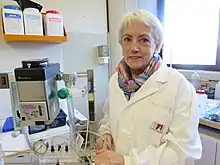Patri Vergara DVM, PhD, DipECLAM | |
|---|---|
 Patri Vergara in 2020. | |
| Born | Patrocinio Vergara Esteras Embid de Ariza, Zaragoza, Spain |
| Nationality | Spanish |
| Occupation(s) | Professor of Physiology, Universitat Autònoma de Barcelona, Spain |
| Title | Professor |
| Academic background | |
| Alma mater | Zaragoza University |
| Academic work | |
| Institutions | Faculty of Veterinary Science, Universidad Autónoma de Barcelona, Spain |
| Main interests | Mast cell & microbiota research, Laboratory Animal Science |
Patri Vergara is a professor in physiology at the veterinary faculty at the Universidad Autónoma de Barcelona, Spain, and in 2011, was elected the first woman president of the International Council for Laboratory Animal Science.
Life and career
Patri Vergara was born in Embid de Ariza, Zaragoza (Spain) and graduated as a Doctor in Veterinary Medicine at Zaragoza University in 1978, and received a PhD in veterinary science in 1983. In 1987, she was appointed senior lecturer in physiology at the Universitat Autònoma de Barcelona, Spain and became a professor in physiology in 2009.
Research
Vergara has published over 80 research papers in three main areas: the role of nitric oxide as the main inhibitory neurotransmitter in the gut;[1][2][3] the role of gastrointestinal hormones (CCK, GLP-1) in the regulation of gastrointestinal motility;[4][5] and the mechanisms involved in the development of inflammatory bowel disease with special attention to mast cells [6][7][8] and NGF [9]
Laboratory Animal Science (LAS)
In 1991, Vergara was nominated by the Spanish Society for Laboratory Animal Science (SECAL) as their scientific representative to the International Council for Laboratory Animal Science (ICLAS). She was later elected by the ICLAS General Assembly to serve on the ICLAS governing board as treasurer from 1999 to 2003 and then as the first woman ICLAS secretary general from 2003 to 2007. In 2011, she was elected ICLAS's first woman president.[10]
Education and training
Vergara co-founded the European College for Laboratory Animal Medicine (ECLAM) in 2000, and she served as a council member and treasurer until 2007. She was also a member of the management board of the Federation of European Laboratory Animal Science Associations (FELASA)[11] from 1994 to 2011 and chair of the FELASA Accreditation Board for Training and Education in Laboratory Animal Science from 2005 to 2014.
Since 2000, she has been principal coordinator of a postgraduate training course[12] and master's degree in LAS[13] at the Universitat Autònoma de Barcelona, and in 2014, was instrumental in the creation of a postgraduate training course in LAS at the Tamil Nadu Veterinary and Animal Sciences University (TANUVAS) in India.
Since 2014, she has served as the Spanish government's representative on the European Platform for Education and Training in Laboratory Animal Science (ETPLAS)[14]
References
- ↑ Allescher HD, Tougas G, Vergara P, Lu S, Daniel EE. Nitric oxide as a putative nonadrenergic noncholinergic inhibitory transmitter in the canine pylorus in vivo Am J Physiol. 1992 Apr;262(4 Pt 1):G695-702. PMID 1348907.
- ↑ Rodríguez-Membrilla A, Martínez V, Jiménez M, Goñalons E, Vergara P. Is nitric oxide the final mediator regulating the migrating myoelectric complex cycle? Am J Physiol. 1995 Feb;268(2 Pt 1):G207-14. PMID 7532363.
- ↑ Porras M, Martín MT, Terán E, Mourelle M, Vergara P. The nitric oxide donor LA-419 ((S-(6-Nitro-oxi-hexahydro-furo (3,2-b) furan-3-1-il) thioacetate)) prevents intestinal dysmotility, bacterial translocation, and inflammation in a rat model of enteritis. J Pharmacol Exp Ther. 2008 Feb;324(2):740-8. Epub 2007 Oct 24. PMID 17959746.
- ↑ Rodríguez-Membrilla A, Martínez V, Vergara P. Peripheral and central cholecystokinin receptors regulate postprandial intestinal motility in the rat. JPharmacol Exp Ther. 1995 Oct;275(1):486-93. PMID 7562590.
- ↑ Giralt M, Vergara P. Glucagonlike peptide-1 (GLP-1) participation in ileal brake induced by intraluminal peptones in rat. Dig Dis Sci. 1999 Feb;44(2):322-9. PMID 10063918.
- ↑ Porras M, Martín MT, Yang PC, Jury J, Perdue MH, Vergara P. Correlation between cyclical epithelial barrier dysfunction and bacterial translocation in the relapses of intestinal inflammation. Inflamm Bowel Dis. 2006 Sep;12(9):843-52. PMID 16954803.
- ↑ Serna H, Porras M, Vergara P. Mast cell stabilizer ketotifen [4-(1-methyl-4-piperidylidene)-4h-benzo[4,5]cyclohepta[1,2-b]thiophen-10(9H)-one fumarate] prevents mucosal mast cell hyperplasia and intestinal dysmotility in experimental Trichinella spiralis inflammation in the rat. J Pharmacol Exp Ther. 2006 Dec;319(3):1104-11. Epub 2006 Sep 20. PMID 16988056.
- ↑ Fernández-Blanco JA, Estévez J, Shea-Donohue T, Martínez V, Vergara P. Changes in Epithelial Barrier Function in Response to Parasitic Infection: Implications for IBD Pathogenesis. J Crohns Colitis. 2015 Jun;9(6):463-76. doi:10.1093/ecco-jcc/jjv056. Epub 2015 Mar 28. PMID 25820018.
- ↑ Torrents D, Torres R, De Mora F, Vergara P. Antinerve growth factor treatment prevents intestinal dysmotility in Trichinella spiralis-infected rats. J Pharmacol Exp Ther. 2002 Aug;302(2):659-65. PMID 12130729.
- ↑ "ICLAS - International Council for Laboratory Animal Science". ICLAS.
- ↑ "Felasa - Federation for Laboratory Animal Science Associations". www.felasa.eu.
- ↑ Barcelona, UAB - Universitat Autònoma de. "Curs en Formació per a Personal Investigador Usuari d'Animals per a Experimentació i Altres Finalitats Científiques (Gener) - UAB Barcelona". www.uab.cat.
- ↑ Barcelona, UAB - Universitat Autònoma de. "Master's Degree in Laboratory Animal Science and Welfare (English) - UAB Barcelona - Spain". www.uab.cat.
- ↑ "Home". www.etplas.eu.